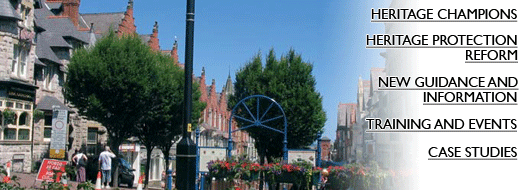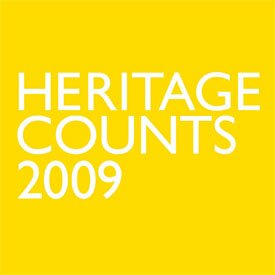HELM Newsletter October 2009
 |
|

Colwyn Bay in Wales: HLF research, published in Heritage Counts 2009, is proving that work to repair and revitalise historic assets can have significant impacts on the character of a place © HLF
|
|
|
Welcome to the latest edition of the HELM newsletter. We are delighted to present this quarterly newsletter for your interest. Your next update will be January 2010. |
|
Building in ContextThis year the Building in Context programme is being revamped. Those of you who have attended previous BiC events will be aware that, despite the programme being designed for Champions, many local authority officers also used to attend. In recognition of this we are revised the programme to make it suitable for both audiences. We are developing a number of different models for the day which will take into account the varying knowledge levels of attendees whilst maximising the benefits of bringing these two audiences together. The new Building in Context will be launched on 20th November and information on upcoming events will be found on the Building in Context website. UK City of CultureIn September, Culture Secretary, Ben Bradshaw, announced the 29 cities and local areas that have expressed an interest in becoming the first UK City of Culture in 2013 (). The winner, who will be announced next Spring, will then host a year long programme of cultural events. All entrants should ensure that heritage is an integral part of any bid. The historic environment is a key component of a city’s distinctiveness and cultural status, and should be at the heart of submissions. We urge Heritage Champions in bidding areas to work with local people, groups and societies to ensure that the potential for local heritage to help shape a successful City of Culture bid is fully exploited. |
|
Changes to the Designation and Scheduled Monument Consent processesFrom 2nd November 2009 English Heritage will take on new responsibilities for national designation and Scheduled Monument Consent from DCMS. This marks another important milestone in the implementation of Heritage Protection Reform. The transfer of responsibilities aims to improve transparency, accountability and efficiency by eliminating double-handling and simplifying procedures. For national designation it devolves the whole of the recommendation process to English Heritage while retaining the decision-making powers of the Secretary of State for Culture, Media and Sport. The changes to Scheduled Monument Consent follow the same streamlining route to allow English Heritage to undertake the whole process to the point of decision by the Secretary of State. A major improvement in the transparency and accountability of the designation process will be achieved by the introduction of a new process of consultation with the owner or manager of a site before English Heritage formulates a recommendation to DCMS, and a new formal review process once a designation decision has been made. Full details of the changes will be posted on the Listing and SMC pages of the EH website. |
|
Recent publications include:Heritage Counts 2009 was launched on 21st October. This year, we have increased the number of resources available to users. As well as national and regional reports, readers can:
In Heritage Counts 2009 we also launched research exploring the historic environment and sense of place. The study found that after controlling for socio-economic factors, people living in historic areas feel more positive about their local area, and have a stronger sense of place. This research adds to the evidence on the importance of the historic environment to both individuals and communities. Go to the Heritage Counts website.
Collaborative guidance from the Homes and Communities Agency and English Heritage to help developers and planners capitalise on the inherited landscape in the shaping of places where people wish to live and work. Download Capitalising on the Inherited Landscape: An introduction to historic characterisation for masterplanning.
England’s 200-year-old network of inland canals and rivers is experiencing a renaissance. Derelict and often forgotten waterways have been rediscovered and are used today more than at the height of the industrial revolution, in ways that the great canal engineers of the 18th and 19th century could never have envisaged. Download England’s Historic Waterways: A working heritage.
The aim of this document is to enable entry of relevant terms relating to archaeological science data into an Historic Environment Record (HER) in a way that is compatible with other archaeological entries and is searchable. The objective is to help specialists choose the right terms for their data in the first instance and to provide the information in an appropriate form for direct entry to the HER. Download Guidelines for the addition of Archaeological Science data to Historic Environment Records.
Despite their historic character, traditional farm buildings are important to the future of the countryside. As well as contributing to its local distinctiveness and historic interest they also represent a major economic asset in terms of their capacity to house new as well as traditional economic activities. Download Historic farm buildings: Extending the evidence base.
England’s Areas of Outstanding Natural Beauty (AONBs) and National Parks cover nearly a quarter of the land area of England, which, together form some of our finest protected landscapes. As well as being landscapes of great aesthetic quality, these protected areas provide a major repository for some of our most important historic sites, containing over 63,300 listed buildings, more than 10,400 nationally important ancient monuments (about half of those designated in England), in excess of 300 designated historic parks and gardens, and a third of English Heritage’s properties. Download A Strategy for English Heritage's Historic Environment Research in Protected Landscapes (Areas of Outstanding Natural Beauty and National Parks.
English Heritage is in the process of developing non-statutory best practice guidance for local authorities and their communities for the identification and management of local heritage assets and the consolidation of these assets as a local list. Download Developing Best Practice Guidance for Local Heritage Assets. |
|
HELM TrainingSince the summer edition, the training team have delivered four training events on Stopping the Rot, training 267 colleagues from Local Authorities and Building Preservation Trusts. If you missed out on this training, do not worry, HELM will deliver this training again in Exeter and Liverpool next year. We will release the full training programme for 2010 in the next edition of the HELM e-newsletter. Still to come in 2009Please reserve your place by e-mailing
English Heritage in collaboration with The Conservation Studio (TCS) are delivering these two specialist workshops for Local Authority staff working with planning departments and assistant-level conservation officers. Case studies will be used to demonstrate the management tools available for maintaining and enhancing conservation areas and illustrate how appraisals can be used as a management tool in spatial planning and development control. Managing Heritage Assets for Added ValueThe social, economic and environmental value of heritage assets has been proven beyond doubt but questions surrounding heritage protection remain. A strategic approach to conservation management as part of planning and development will help not only to protect and enhance conservation areas but also to achieve broader corporate objectives. A national seminar series has been developed by the Historic Towns Forum and English Heritage to support those in local authorities responsible for strategic management and policy making (It is not aimed at conservation practitioners; courses on the theme of conservation areas appraisals and management proposals are available on the HELM training programme). Fee: £50 per person per event - this includes all refreshments, seminar materials and the site visit. For more information or to book your place visit: http://www.historictownsforum.org/CAAR |
|
|
Please send us your case studies! Case studies are showcased on the HELM website as examples of good practice and can be searched by particular topic and administrative area. They may be used to illustrate new guidance and presentations. To find out more and receive a case studies form, visit the HELM website case studies section or .
A tenant farmer is seeking to make the most of the historic and natural assets on his land: the deserted medieval village of Ulnaby and the ancient pasture in which the village’s earthwork remains are preserved. With support, advice and grants from English Heritage and Natural England, primarily through a Higher Level Stewardship scheme, the farmer has put in place a presentation and interpretation scheme and encouraged access to the land, and turned his existing tea room and farm shop into a small but profitable visitor centre. |
|
Contact detailsIf you have any queries relating to this newsletter please email or phone Timothy Brooks on . If you wish to unsubscribe, please use the unsubscribe link. |


 Capitalising on the Inherited Landscape: An introduction to historic characterisation for masterplanning
Capitalising on the Inherited Landscape: An introduction to historic characterisation for masterplanning England’s Historic Waterways: A working heritage
England’s Historic Waterways: A working heritage Guidelines for the addition of Archaeological Science data to Historic Environment Records
Guidelines for the addition of Archaeological Science data to Historic Environment Records Historic farm buildings: Extending the evidence base
Historic farm buildings: Extending the evidence base A Strategy for English Heritage's Historic Environment Research in Protected Landscapes (Areas of Outstanding Natural Beauty and National Parks)
A Strategy for English Heritage's Historic Environment Research in Protected Landscapes (Areas of Outstanding Natural Beauty and National Parks) Developing Best Practice Guidance for Local Heritage Assets
Developing Best Practice Guidance for Local Heritage Assets Ulnaby
Ulnaby